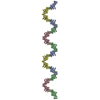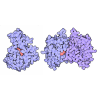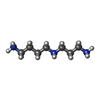[English] 日本語
 Yorodumi
Yorodumi- PDB-9or6: Crystal structure of PprA S-F-S tetramer from Deinococcus radiodurans -
+ Open data
Open data
- Basic information
Basic information
| Entry | Database: PDB / ID: 9or6 | ||||||
|---|---|---|---|---|---|---|---|
| Title | Crystal structure of PprA S-F-S tetramer from Deinococcus radiodurans | ||||||
 Components Components | DNA repair protein PprA | ||||||
 Keywords Keywords | DNA BINDING PROTEIN / PprA / Deinococcus / Deinococcus radiodurans / D. radiodurans / DNA repair / Genome reassembly / self-assembly / protein filament | ||||||
| Function / homology | cellular response to desiccation / cellular response to gamma radiation / double-strand break repair via nonhomologous end joining / double-stranded DNA binding / damaged DNA binding / DNA repair / SPERMIDINE / DNA repair protein PprA Function and homology information Function and homology information | ||||||
| Biological species |  Deinococcus radiodurans (radioresistant) Deinococcus radiodurans (radioresistant) | ||||||
| Method |  X-RAY DIFFRACTION / X-RAY DIFFRACTION /  SYNCHROTRON / SYNCHROTRON /  MOLECULAR REPLACEMENT / Resolution: 2.9 Å MOLECULAR REPLACEMENT / Resolution: 2.9 Å | ||||||
 Authors Authors | Szabla, R. / Junop, M.S. / Wood, K. | ||||||
| Funding support |  Canada, 1items Canada, 1items
| ||||||
 Citation Citation |  Journal: To Be Published Journal: To Be PublishedTitle: Self-assembly of PprA from D.radiodurans Authors: Szabla, R. / Junop, M.S. | ||||||
| History |
|
- Structure visualization
Structure visualization
| Structure viewer | Molecule:  Molmil Molmil Jmol/JSmol Jmol/JSmol |
|---|
- Downloads & links
Downloads & links
- Download
Download
| PDBx/mmCIF format |  9or6.cif.gz 9or6.cif.gz | 122.4 KB | Display |  PDBx/mmCIF format PDBx/mmCIF format |
|---|---|---|---|---|
| PDB format |  pdb9or6.ent.gz pdb9or6.ent.gz | 86.6 KB | Display |  PDB format PDB format |
| PDBx/mmJSON format |  9or6.json.gz 9or6.json.gz | Tree view |  PDBx/mmJSON format PDBx/mmJSON format | |
| Others |  Other downloads Other downloads |
-Validation report
| Summary document |  9or6_validation.pdf.gz 9or6_validation.pdf.gz | 447.7 KB | Display |  wwPDB validaton report wwPDB validaton report |
|---|---|---|---|---|
| Full document |  9or6_full_validation.pdf.gz 9or6_full_validation.pdf.gz | 452 KB | Display | |
| Data in XML |  9or6_validation.xml.gz 9or6_validation.xml.gz | 23.4 KB | Display | |
| Data in CIF |  9or6_validation.cif.gz 9or6_validation.cif.gz | 29.6 KB | Display | |
| Arichive directory |  https://data.pdbj.org/pub/pdb/validation_reports/or/9or6 https://data.pdbj.org/pub/pdb/validation_reports/or/9or6 ftp://data.pdbj.org/pub/pdb/validation_reports/or/9or6 ftp://data.pdbj.org/pub/pdb/validation_reports/or/9or6 | HTTPS FTP |
-Related structure data
| Related structure data |  9om8C  9yi3C  9yl4C  9yupC C: citing same article ( |
|---|---|
| Similar structure data | Similarity search - Function & homology  F&H Search F&H Search |
| Experimental dataset #1 | Data reference:  10.5281/zenodo.15485035 / Data set type: diffraction image data 10.5281/zenodo.15485035 / Data set type: diffraction image data |
- Links
Links
- Assembly
Assembly
| Deposited unit | 
| ||||||||||||
|---|---|---|---|---|---|---|---|---|---|---|---|---|---|
| 1 | 
| ||||||||||||
| Unit cell |
|
- Components
Components
| #1: Protein | Mass: 29731.230 Da / Num. of mol.: 2 / Mutation: D180K, D184K Source method: isolated from a genetically manipulated source Details: 1-8 deletion of PprA from D.radiodurans with D180K/D184K mutation Source: (gene. exp.)  Deinococcus radiodurans (radioresistant) Deinococcus radiodurans (radioresistant)Strain: R1 / Gene: pprA, DR_A0346 / Plasmid: pMJ5666 Details (production host): pDEST-527-based expression plasmid Production host:  #2: Chemical | #3: Water | ChemComp-HOH / | Has ligand of interest | N | Has protein modification | N | |
|---|
-Experimental details
-Experiment
| Experiment | Method:  X-RAY DIFFRACTION / Number of used crystals: 1 X-RAY DIFFRACTION / Number of used crystals: 1 |
|---|
- Sample preparation
Sample preparation
| Crystal | Density Matthews: 2.46 Å3/Da / Density % sol: 50 % / Description: long and thin hexagonal-based prisms |
|---|---|
| Crystal grow | Temperature: 293.15 K / Method: vapor diffusion, hanging drop Details: 1.5 ul of protein solution was mixed with 1.0 uL of crystallization solution and hung upside-down in a sealed chamber containing 1mL of well solution. | Protein solution: 5.0 mg/mL PprA (168 ...Details: 1.5 ul of protein solution was mixed with 1.0 uL of crystallization solution and hung upside-down in a sealed chamber containing 1mL of well solution. | Protein solution: 5.0 mg/mL PprA (168 uM), 43bp dsDNA (101 uM), 150mM KCl, 20mM Tris, pH 7.5, 1 mM MgCl2. | Crystallization solution (Molecular Dimensions - Morpheus 2 #94): 10 mM Spermine tetrahydrochloride, 10 mM Spermidine trihydrochloride, 10 mM 1,4 Diaminobutane dihydrochloride, 10 mM DL Ornithine monohydrochloride 0.1M Gly-Gly, AMPD, pH 8.5, 13% w/v PEG 4000, 21% w/v 1,2,6 Hexanetriol. | Well solution: 2.0 M Ammonium sulfate. PH range: 7.5-8.5 / Temp details: Temperature-controlled incubator |
-Data collection
| Diffraction | Mean temperature: 100 K / Ambient temp details: Nitrogen cryo-stream / Serial crystal experiment: N |
|---|---|
| Diffraction source | Source:  SYNCHROTRON / Site: SYNCHROTRON / Site:  CLSI CLSI  / Beamline: 08ID-1 / Wavelength: 0.97934 Å / Beamline: 08ID-1 / Wavelength: 0.97934 Å |
| Detector | Type: DECTRIS PILATUS3 6M / Detector: PIXEL / Date: Feb 13, 2019 / Details: CMCF-ID optics setup |
| Radiation | Monochromator: CMCF-ID default optics (Feb 2019) / Protocol: SINGLE WAVELENGTH / Monochromatic (M) / Laue (L): M / Scattering type: x-ray |
| Radiation wavelength | Wavelength: 0.97934 Å / Relative weight: 1 |
| Reflection | Resolution: 2.9→90.774 Å / Num. obs: 13352 / % possible obs: 96.2 % / Redundancy: 3.3 % / Biso Wilson estimate: 51.01 Å2 / CC1/2: 0.993 / Rmerge(I) obs: 0.094 / Rpim(I) all: 0.069 / Rrim(I) all: 0.13 / Net I/σ(I): 9.6 |
| Reflection shell | Resolution: 2.904→2.954 Å / Redundancy: 3.4 % / Rmerge(I) obs: 0.443 / Mean I/σ(I) obs: 2.4 / Num. unique obs: 633 / CC1/2: 0.756 / Rpim(I) all: 0.417 / Rrim(I) all: 0.61 / % possible all: 100 |
- Processing
Processing
| Software |
| ||||||||||||||||||||||||||||||||||||||||||
|---|---|---|---|---|---|---|---|---|---|---|---|---|---|---|---|---|---|---|---|---|---|---|---|---|---|---|---|---|---|---|---|---|---|---|---|---|---|---|---|---|---|---|---|
| Refinement | Method to determine structure:  MOLECULAR REPLACEMENT / Resolution: 2.9→90.77 Å / SU ML: 0.4166 / Cross valid method: FREE R-VALUE / σ(F): 1.35 / Phase error: 24.2516 MOLECULAR REPLACEMENT / Resolution: 2.9→90.77 Å / SU ML: 0.4166 / Cross valid method: FREE R-VALUE / σ(F): 1.35 / Phase error: 24.2516 Stereochemistry target values: GeoStd + Monomer Library + CDL v1.2
| ||||||||||||||||||||||||||||||||||||||||||
| Solvent computation | Shrinkage radii: 0.9 Å / VDW probe radii: 1.1 Å / Solvent model: FLAT BULK SOLVENT MODEL | ||||||||||||||||||||||||||||||||||||||||||
| Displacement parameters | Biso mean: 51.11 Å2 | ||||||||||||||||||||||||||||||||||||||||||
| Refinement step | Cycle: LAST / Resolution: 2.9→90.77 Å
| ||||||||||||||||||||||||||||||||||||||||||
| Refine LS restraints |
| ||||||||||||||||||||||||||||||||||||||||||
| LS refinement shell |
|
 Movie
Movie Controller
Controller


 PDBj
PDBj



